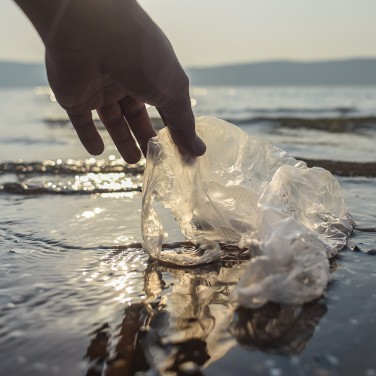How Plastic in the Ocean Affects Us
By Kevin Ritchart
Oceans cover more than 70 percent of the earth’s surface and serve as one of our most valuable natural resources. While we rely on oceans for food, commerce, and so much more, various types of manmade pollution are causing them to degrade at an alarming rate.
These are some of the main threats to the health of the planet’s oceans and marine life, according to the National Resources Defense Council.
Oceans on Acid
The burning of fossil fuels doesn’t just pollute the air. It pollutes the oceans too. Oceans absorb as much as a quarter of all manmade carbon emissions, which changes the pH of surface water and leads to acidification.
And the problem is getting worse. Oceans are acidifying faster now than they have over the past 300 million years. If manmade carbon emissions continue at the current rate, oceans could be nearly 150 percent more acidic at the end of the 21st century than they are today.
The result will be the further decay of marine ecosystems, which coastal economies depend on for survival. To build their skeletons, sea creatures like mussels, clams, coral, and oysters require calcium carbonate.
Ocean carbonate levels decrease when acidity levels rise, which threatens the health of these creatures. Bivalves are at the bottom of the food chain, so if they’re not thriving, neither are the fish, birds, and other aquatic life that depend on them for food.
More acidic waters also can contribute to the bleaching of coral reefs and make it more difficult for some species of fish to sense predators or hunt for prey.
And the effects of ocean acidification don’t end with the waves that crash into the shoreline. The American shellfish industry is a billion-dollar business that serves as the economic backbone of many coastal communities across the country.
Declining harvests in the waters that border these communities has been linked to increasing acidity. The oyster industry in the Pacific Northwest has lost nearly $110 million and over 3,000 jobs in recent years as a result of the acidification of oceans.
The Plastic Problem
Much of the trash that ends up polluting the oceans each year is non-biodegradable plastic. Single-use grocery bags, water bottles, drinking straws, and yogurt containers are just some of the eight million metric tons of plastic products thrown away by consumers.
Instead of being recycled, these products persist in our environment for a millennium, polluting beaches, endangering marine life, and harming birds. While some of these products are dumped directly into the water, an estimated 80 percent of marine litter arrives in oceans from land-based sources like storm drains and sewers.
There’s a 600,000 square mile island of waste in the Pacific Ocean known as the Great Pacific Garbage Patch. It contains approximately 79,000 tons of discarded material. Scientists from a nonprofit organization in the Netherlands called Ocean Cleanup have been studying the patch and attempting to zero in on where the bulk of the trash is coming from.
Oil from boats, planes, cars, and other machines also is commonly found in ocean waters. Chemical discharge from factories, raw sewage overflow from water treatment plants, and stormwater and agricultural runoff has found its way into the oceans and added to the pollution problem.
Too Much Noise
Aquatic creatures rely heavily on sound for food, mating, and navigation. Sound waves can travel farther and faster under water than they do in the air, which helps marine mammals like dolphins and whales communicate.
But increasing levels of manmade noise pollution are altering the underwater landscape and harming many species worldwide. There are approximately 60,000 commercial tankers and container ships navigating our oceans at any given time, and the noise they create has been proven to shrink the sensory range of wildlife.
High-intensity sonar equipment deployed by the U.S. Navy during testing and training has been shown to cause the same types of problems, particularly for whales. And ships equipped with high-powered air guns that help in the hunt for offshore oil and gas create seismic blasts that can travel up to 2,500 miles and disrupt the foraging and mating habits of whales and push some commercial fish species to abandon their habitat.
Drills and Spills
Along with the noise, offshore drilling by the oil and gas industries emits toxic byproducts, releases high levels of greenhouse gases, and causes thousands of spills annually in U.S. waters. The oil can linger for decades and cause permanent damage to marine ecosystems.
Oil still remains in Alaska’s Prince William Sound from the 1989 Exxon Valdez tanker spill, and the 2010 BP Deepwater Horizon offshore drilling mishap spread millions of gallons into the Gulf of Mexico.
Cleanup efforts often remove only a fraction of the oil and can sometimes employ hazardous technologies. The 1.8 million gallons of chemical dispersants used to corral the 2010 BP spill are dangerous pollutants themselves.
How You Can Help
While they may seem like small changes, there are a lot of things individuals can do to help combat the damage being done to our oceans. Reducing water consumption, minimizing use of non-biodegradable plastics in favor of reusable glassware, and organizing local cleanup efforts are some very real and impactful ways to help preserve our oceans and their coastlines.
And if you want to take part in an existing effort, a company called 4Ocean sells bracelets made from 100 percent recycled materials. In return for each bracelet purchase, the company will remove one pound of trash from our waterways. In less than two years, 4Ocean has removed almost 630,000 pounds of trash from 27 countries around the world.
